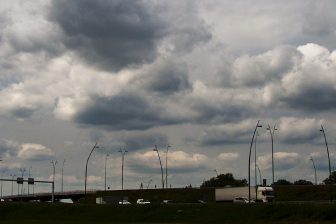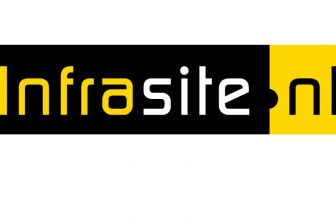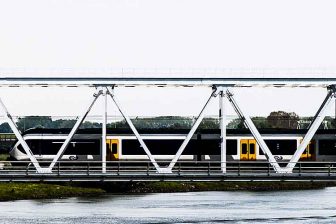EC action programme Inland Waterway Transport
Brussels, Belgium – Januari 17 2006 the Commission proposed a multi-annual Action Programme in order to foster transport by inland waterways in Europe. Inland Waterway Transport is a significant option to improve Europe’s transport system which is suffering from congestion, delays and which harms the environment. Shifting more freight to water will help to deal with the constantly growing freight flows. Moreover, Inland Waterway Transport has great potential to be fully integrated into the door-to-door logistics chains. The Action Programme addresses five key components: services, fleet, staff, image and infrastructure.
Vice-President of the European Commission in charge of transport, Jacques Barrot, commented: “The NAIADES[1] action plan is a contribution to Europe’s strategy for growth and employment. With a fleet of 11.000 vessels and a capacity equalling 10.000 trains or 440.000 trucks, inland waterways can make transport in Europe more efficient, reliable and environmental friendly. Europe cannot afford to leave that potential untappedâ€
The Action Programme focuses on five strategic areas:
– creating favourable conditions for services and attracting new markets;
– stimulating fleet modernisation and innovation;
– attracting new workforce and increasing investment in human capital;
– promoting Inland Waterway Transport as a successful business partner through a promotional network and;
– providing an adequate inland waterway infrastructure.
Finally, the Commission looks at the different options for modernising the regulatory environment to take up the challenges ahead.
The time frame for the implementation of the plan is the period 2006 – 2013. The programme is addressed to all levels responsible for Inland Waterway Transport, the industry itself, Member States and the European Union.
More information on the NAIADES Action Programme is available at:
europa.eu.int/comm/transport/iw/index_en.htm
[1] Inspired by the fresh water nymphs of Greek mythology, the programme has been called “NAIADES†– Navigation And Inland Waterway Action and Development in Europe.
Questions & Answers
Why should the European Union do more to increase transport by inland waterways?
Freight transport volumes in Europe are expected to increase by one third until 2015, because of the growing overseas trade and the EU enlargement.
Present patterns of transport growth and its reliance on road transport are increasingly leading to congestion and pollution. If no action is taken, many of these negative impacts of road transport would worsen, with significant economic, environmental and social repercussions.
This is why the EU committed itself to pursue the goal of shifting transport to less energy-intensive, less polluting and safer transport modes. Rail, short sea shipping and above all Inland Waterway Transport (hereafter IWT) which has a major unexploited capacity, are an obvious choice in reaching these targets and handle the constantly growing freight flows.
Where does Europe’s IWT system currently stand?
While inland shipping’s traditional strength lies in the long-distance haulage of bulk transport, since the 1990´s it is also successfully entering new markets such as container transport, intermodal transport and short distance traffic. The hinterland transport of maritime containers by inland waterways has prospered in North-Western Europe during the last 10 to 15 years.
In these regions inland shipping in general has conquered a significant modal share. For instance, in the Netherlands IWT presents a modal share of more than 40%. Moreover, between 1997 and 2004 impressive traffic growth rates (in tonne-km) of more than 50% in Belgium and of more than 35% in France have been achieved. These examples show that a pro-active inland waterway policy is an important step towards the improvement of IWT.
Compared to the steady growth of IWT in Western Europe, on the Danube River and other waterways of Central and Eastern Europe, the share of IWT is still significantly smaller. New industrial activities in new Member States and candidate countries are generating demand for containerised transport on a large scale, but this is currently being captured by the road transport sector. At present only 7 to 10% of the Danube’s maximum capacity is actually used.
What are the main hurdles to the development of IWT?
Inland navigation has experienced some success, but a number of hurdles still have to be overcome if it is to unlock its full potential.
The IWT sector is traditionally characterised by a high number of private ship-owners (SME´s). The fragmented market structure and strong competition have resulted in limited re-investment ability. Combined with the longevity of vessels, this forms a high threshold for the modernisation of the fleet. On the other hand, difficult access to capital and the financial risks involved with the required investments hinder the establishment of new services, and form an unmistakable barrier to attract newcomers to the sector.
In addition, the sector faces a general lack of skilled labour, because working conditions on board and career perspectives may not seem as attractive as elsewhere. Together with the lack of successors and hence the gradual decrease of the family-dependent ship-owner structure, this will pose a major problem to the future development of inland navigation.
The way inland navigation is perceived by the general public, does often not correspond to reality. Even freight forwarders and shipping companies are rarely aware of the advantages of IWT. The sector is often considered to be a passive, slow and old-fashioned mode of transport. Apart from some exceptions, promotional efforts are rarely co-ordinated and often lack a clear communication strategy.
Concerning the waterway network itself, insufficient financial means are being reserved for maintenance of the waterway infrastructure and the elimination of strategic bottlenecks. At the same time, construction projects meet growing environmental concerns. And often local and regional planning processes do not consider the opportunities that IWT can offer. Information and Communication technologies such as used in River Information Services still require further development.
Finally, the institutional framework for inland navigation in Europe is fragmented, as it is currently administered under different regimes, at different levels and with overlapping regulatory activities (EC/EU, the Central Commission for Navigation on the Rhine, the Danube Commission, the United Nations Economic Commission for Europe and the European Conference of Ministers of Transport). This leads to an overall reduced effectiveness and a lack of political attention and ultimately results in a complex business environment.
What are the objectives and main provisions of the NAIADES Action Programme? What needs to be done?
The NAIADES Action Programme is an important step forward to fully exploit the market potential of inland navigation. Being a comprehensive programme, it combines legislative and policy instruments with support and funding programmes and focuses on five inter-dependent strategic areas (see attached table). These key areas are rounded off by an organisational structure deemed to assist the implementation of the programme.
What is new about the Action Programme?
The Commission will draw up, for example, a Funding Handbook for IWT in 2006. This will provide information on funding subjects, funding criteria, example projects, contact persons and funding organisations. In order to contribute to a fair entrepreneurial climate and the ‘ease-of-use’ of inland navigation, the Commission also intends to identify the administrative bottlenecks at whatever level, which are currently blocking the development of IWT.
Priority will also be given to state aid guidelines in the field of IWT, in order to create a level playing field. The state aid guidelines will apply to funding schemes to facilitate investment and attract new markets, and support programmes for fleet modernisation and innovation. Special attention shall also be given to the potential of the IWT Reserve Fund, established by the profession, in terms of innovative concepts around services, vessels and their crew as well as to its financial sources.
Several Member States have already successfully set-up promotion centres for IWT, which can set an example to others. Yet there is no coordination of the promotion of IWT at European level. Therefore the Commission aims at the establishment of one European promotional network between the national agencies and focal points. At the same time it will offer support the set-up of new promotional agencies in other Member States that have opportunities for inland waterway navigation and where these kinds of promotion activities are currently lacking.
Concerning the need for detailed statistical data on the market developments, a system for a European Market Observation is being developed.
With the intention to ensure the coordinated improvement and maintenance of waterway infrastructure and transhipment facilities, the Commission proposes to establish a European IWT Infrastructure Development Plan. This plan would go beyond the existing TEN-T priority projects and also include other projects of ‘common interest’ and smaller waterway networks, while aiming to take into account environmental concerns. The appointment of a dedicated European Co-ordinator will further help to support the implementation of the TEN-T priority projects, i.e. the Seine-Scheldt connection and the removal of bottlenecks on the Danube.
Finally, the current framework needs to be changed. The Commission is presently examining different options for a future organisational structure. This institutional framework could play a role in coordinating the implementation of the NAIADES Action Programme.
How much will it cost to implement the NAIADES Action Programme? Who will finance it?
The programme is composed of various types of actions which imply different costs. They are either of a legislative nature, e.g. the harmonisation of technical and manning requirements; of a policy coordinative nature, like the TEN Coordinator, or of a supportive nature. Examples of the latter are the EU RTD and support programmes and the national support programmes.
Depending on the nature of the instruments, some are to be financed by the EU, others by Member States, the industry or jointly by all addressed parties, i.e. the industry, Member States and the EU. The revised IWT Reserve Fund, could for example be financed to equal parts by the IWT sector, the EU and Member States.
However not all actions require a new budget line; many actions can be taken with existing financial resources, e.g. the existing EU support programmes and the TEN-T projects. This only requires giving higher priority to IWT. For instance in the case of the TEN-T projects, a larger part of the TEN-T budget should be allocated for waterway projects. Finally, the various actions and measures indicated in the programme still need to be further defined in the course of the deliberation with the Council and the European Parliament.
NAIADES ACTION PROGRAMME:
PROPOSED ACTIONS AND MEASURES
1. CREATE FAVOURABLE CONDITIONS FOR SERVICES
Attract new markets
Investigate and implement new logistics concepts
Support liner services for intermodal transport
Improve co-operation between modes and within the sector
Encourage entrepreneurship
Attract newcomers
Facilitate access to finance for SMEs
Improve administrative and regulatory framework
Abolish administrative barriers to IWT development
Ensure a level playing field/avoid competition distortions
Improve co-ordination between relevant public services
2. STIMULATE FLEET MODERNISATION AND INNOVATION
Improve logistics efficiency, safety and environmental performance of IWT
Develop and facilitate use of innovative vessel concepts and technologies
Encourage use of safety-enhancing technologies
Encourage use of eco-efficient engines and renewable energy sources
Develop refit concepts for existing vessels
3. PROMOTE JOBS AND SKILLS
Attract workforce
Improve working and social conditions
Stimulate labour mobility
Create awareness and improve career opportunities
Enhance cooperation regarding mutual recognition of qualifications
Invest in human capital
Preserve education and training institutes
Stimulate life-long learning
Enhance entrepreneurial skills
4. IMPROVE IMAGE AND CO-OPERATION
Promote inland navigation as a successful partner in business
Support and coordinate promotion activities
Influence logistics decision-making by public relations
Set up and expand EU IWT promotion and development network
Set up national promotion and development structures
Provide political, practical and financial support for promotion centres
Appoint national focal points within administrations
Integrate national promotion structures and focal points into a European network
Monitor trends and developments within the IWT market
Harmonise collection of data at all levels
Ensure availability of compatible source data
5. PROVIDE ADEQUATE INFRASTRUCTURE
Improve multi-modal network
Maintain and improve the European IWT network
Foster the mutual understanding of multi-purpose use of waterways
Encourage the development of port and transhipment facilities – also in candidate and associated countries
(Re)develop industrial sites nearby waterways
Implement River Information Services
Support and co-ordinate development and implementation of RIS in Europe
U las zojuist één van de gratis premium artikelen
Onbeperkt lezen? Profiteer nu van de introductieaanbieding voor € 10,- per maand.
Bent u al abonnee?



